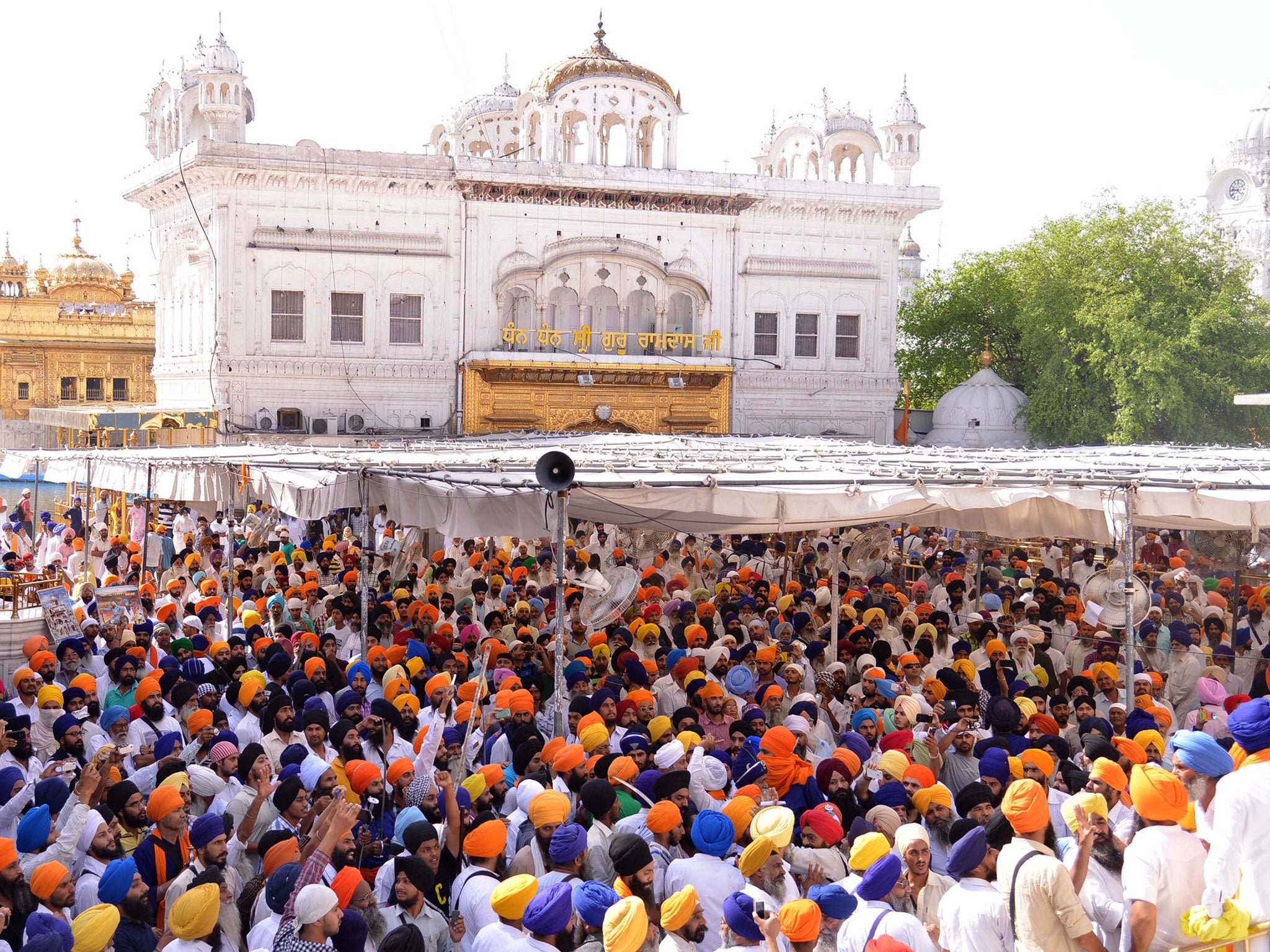Amritsar, home of the Golden Temple in India, has always been shrouded in controversy and Britain is not without its share of the blame
In 1919 a British general gave orders to fire into a huge crowd of peaceful demonstrators. This may seem like an anachronism, but beneath the surface not that much has really changed


Your support helps us to tell the story
From reproductive rights to climate change to Big Tech, The Independent is on the ground when the story is developing. Whether it's investigating the financials of Elon Musk's pro-Trump PAC or producing our latest documentary, 'The A Word', which shines a light on the American women fighting for reproductive rights, we know how important it is to parse out the facts from the messaging.
At such a critical moment in US history, we need reporters on the ground. Your donation allows us to keep sending journalists to speak to both sides of the story.
The Independent is trusted by Americans across the entire political spectrum. And unlike many other quality news outlets, we choose not to lock Americans out of our reporting and analysis with paywalls. We believe quality journalism should be available to everyone, paid for by those who can afford it.
Your support makes all the difference.Earlier this week Justin Trudeau, the Prime Minister of Canada, and his wife, Sophie, were photographed at the Sikh Golden Temple in Amritsar. It is an exceptionally beautiful building with water in three sides. In India, perhaps only the Taj Mahal is finer.
Despite its visual delights, however, it is hard for Amritsar to escape controversy. For example, the Indian government wasn’t pleased with Trudeau’s visit. He is credited with advocating a separate Sikh homeland, called Khalistan, in the Punjab region of which Amritsar is part. That would mightily displease the Prime Minister of India, Narenda Modi, who is a Hindu nationalist.
But for people who know Britain’s record as a colonial power, Amritsar, even with its marvellous temple, has negative connotations. What happened there in 1919 may be the greatest blot on the reputation of the British Empire – and that’s saying something. For that is where a British general gave orders to fire into a huge crowd of peaceful demonstrators.
Discontent with British rule had been growing. Mahatma Gandhi had returned to India from South Africa in 1915 and had become leader of the Indian National Congress where he practised an effective non-violent resistance. So, when, on 10 April 1919, Satya Pal and Saifuddin Kitchlew, two popular proponents of the movement led by Gandhi, were called to the deputy commissioner's residence in Amritsar, arrested and sent off by car to a remote hill town, things were starting to hot up – or, as a local official put it, “it was at this point that things had begun to go badly wrong”.
Workers in Amritsar immediately went on strike. A crowd of about 50,000 people marched to the offices of the deputy commissioner to protest against the arrest of the two leaders. It was now that a spiral of violence took hold. The crowd was stopped and fired upon near a railway footbridge. As always there are conflicting estimates of how many were killed or wounded. The British said the number of those killed was 12 and of those wounded between 20 and 30. Evidence before an inquiry of the Indian National Congress put the number of the dead between 20 and 30.
The next day, 11 April, the man whose name is forever associated with the Amritsar massacre, General Dyer, arrived on the scene. He is an example of what was once a common type, of British origin but born in India and whose family had lived and worked there for many years. I encountered one or two of them in the late 1950s when they had finally come back to Britain to retire – I knew their children. Their sons and daughters wouldn’t follow them; their parents’ way of life was over.
General Dyer’s father had managed a brewery. He was sent to school in Ireland and then went to the Royal Military College at Sandhurst. He wasn’t a cerebral type, but according to Nick Lloyd’s telling of the story, The Amritsar Massacre, an acquaintance said that “he does not know what fear means and is happiest when crawling over a Burmese stockade with a revolver hanging from his teeth”. But he didn’t see much active service during the First World War apart from a brief spell in Eastern Persia where his health suffered. When he arrived in Amritsar he was, as he had been for a number of years, in constant pain – a troubled figure.
He must have thought that dealing with the Amritsar situation would finally make his name. On 13 April, the day of a traditional festival, thousands of Sikhs, Muslims and Hindus had gathered to picnic and listen to speeches in the Jallianwala Bagh, a public garden located in the vicinity of the Golden Temple. It was later established that there was no evidence that the crowd was in effect a conspiracy aimed at overthrowing British rule. It was just a letting off steam.
An hour after the meeting began as scheduled at 4.30 pm, General Dyer arrived with a group of sixty-five Gurkha and twenty-five Baluchi soldiers. "Roughly speaking", General Dyer would later claim, ‘I understood the position to be that civil law was at an end and that military law would have to take its place for the time being.’
Without warning the crowd to disperse, General Dyer blocked the main exits and ordered his troops to begin shooting toward the densest sections of the crowd. Firing continued for approximately ten minutes. A British inquiry into the massacre placed the death toll at 379. The Indian National Congress concluded that approximately 1,000 people were killed.
Afterwards, General Dyer said: “I fired and continued to fire until the crowd dispersed and I consider this is the least amount of firing which would produce the necessary moral, and widespread effect it was my duty to produce, if I was to justify my action…It was no longer a question of merely dispersing the crowd; but one of producing a sufficient moral effect, from a military point of view, not only on those who were present but more especially throughout the Punjab. There could be no question of undue severity.”
When I first read these words, I reflected that they came from another age which had long passed into history. Indeed, when I look at photographs of General Dyer with his stiff, smart moustache I immediately view him as an anachronism. But then I turn on the TV news and see the bombardment of eastern Ghouta near Damascus by President Assad’s forces, where 426 people have been killed this week, and I realise that there are still plenty of thugs like General Dyer about.
Join our commenting forum
Join thought-provoking conversations, follow other Independent readers and see their replies
Comments